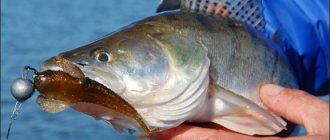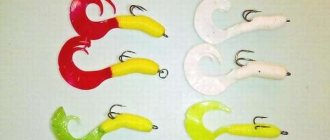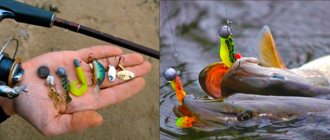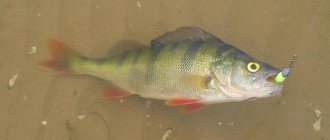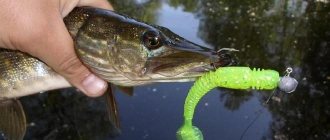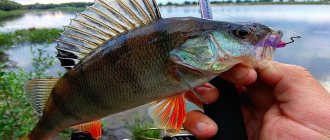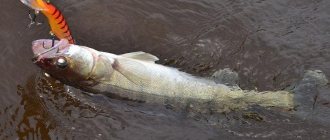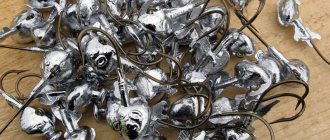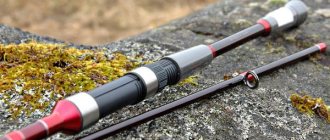Nowadays, a spinning fisherman does not need any gear, bait, or accessories for fishing. In big cities you can buy almost everything by visiting a large fishing store.
Specific requirements can be met through online shopping, often resulting in significant savings. But having bought an armful of spinning rods and a mountain of baits, an angler will not become an experienced spinning player. You still need to master fishing methods, and for this you need to learn how to use bait correctly, including mastering how to mount these baits, if necessary, and fishing with silicone baits just involves the use of several basic types of fishing, for which mounting the bait is of key importance .
There are several main types of installation of silicone baits. They are determined by the fishing method that the spinning angler chooses, the conditions of the upcoming fishing and, to some extent, the object that the angler is aiming to catch.
Classical
Mounting a silicone bait on a jig head is considered classic . A jig head is a lead weight that can have a different shape, with a single hook sticking out.
The advantage of the jig head is the ease of installation of the silicone bait : you just need to put it on the hook. The disadvantages of the jig head are its unsatisfactory flight qualities (it can somersault in flight when casting) and the fact that at the base of the hook there is a lead “tooth” or other device designed to prevent the bait from sliding off the hook.
This “tooth” breaks the head part of the soft bait, rendering it unusable. Russian fishermen have figured out how to eliminate this drawback. To do this, the “tooth” is cut off , then one of the hooks of the tee is stuck into the “back” part of the body of the bait, and the eye of the tee is put on the ring of the jig head. Thus, after the jig head is fastened with a clasp, the tee becomes an additional element of the equipment, which contributes to better bites, and the silicone bait is securely fixed, without any damage.
This type of installation is especially effective when catching pike perch, which, as many anglers know, often prefers to hit the “head” of the bait. Of course, such equipment is used in places where there are no hooks.
Methods for attaching silicone baits
Date: February 27, 2015 | 254
In addition to the correct choice of silicone bait, the way in which it is attached to the hooks and how it is mounted is also very important. Yes, choosing a shape, size, getting into a color that the fish now likes is all cool. But, it’s enough to assemble the rig incorrectly, attach the bait in the wrong way or on the wrong thing - and that’s it, you won’t see a catch, or it will be much scarcer than if we did everything correctly. So, it makes sense to talk specifically about different silicone baits, about edible bait and methods of its installation, attachment to hooks.
I’ll go through the main forms of baits and tell you which mounts and rigging methods are most suitable for them.
Vibrating tails are best attached to a jig head. On a rigid mounting, which is a jig head, the body of the vibrotail is clearly fixed and, when retrieved, has slight deviations along the trajectory. But the tail plays perfectly in relation to the body. It is this vibration of the tail that is the main attracting factor for the vibrotail.
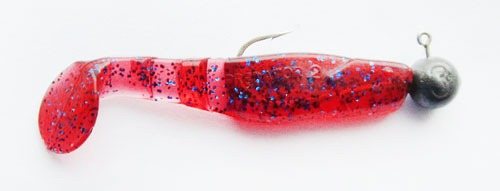
Thin vibrating tails can be attached to a jig head in an unusual way, hiding the sting almost like in an offset hook. This is practiced in places where there are a lot of snags.
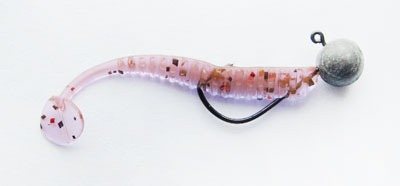
Vibrating tails can also be mounted on a hinged mounting with a single hook, and narrow vibrating tails are often used with offset hooks. However, in these cases you should be very careful in choosing the weight of the weight. Only over a short range of scales will the vibrating tail play normally. This is due to the vibrotail’s own freedom of movement of the body relative to the weight; and the tail, relative to the body, may not play as it should. So, if you are planning to mount a vibrating tail not on a jig head, check the specific bait model for the quality of the game with a specific weight of the weight.
Some narrow-bodied vibrotails, usually with a worm-like body, can also be used for such an unusual method of installation as “wacky”, when the bait is threaded with a hook somewhere in the middle and dangles at both ends.
Twisters work well on a wide variety of rigs. Perhaps the twister is the most unpretentious and versatile bait in terms of installation.

The twister can be mounted on a jig head or on a swivel mounting. Twisters go well with single, double, and offset hooks. Of course, the popularity of using a twister joint is somewhat higher than using a jig head.
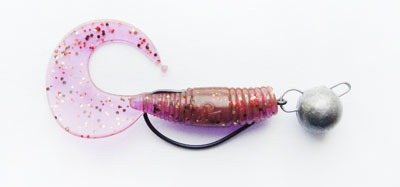
Twisters mounted on a single or offset hook are very often used for fishing with a retractable leash.
Slugs , as a passive bait, are located more towards the hinged nozzle. You can, of course, use a jig head, but the body of the bait will have less mobility.

Slugs work great on a hinged rig with a single hook, when only a small part of the bait is occupied by it, and the majority plays freely and naturally (but with this rig, you should wait well between the start of the bite and the hook).
Also, many slugs are well adapted for installation with an offset hook, having a special slot on the back to hide its tip. However, slugs without such a feature can be attached and used with offset hooks just fine.

When a slug is mounted on an offset hook, there are many options for using it. You can put a rather heavy eared sinker and move the slug in sharp jumps, in steps, along the bottom. You can fish with a light weight, using a wide variety of, mostly smooth, movements in the retrieve. You can use a slug on an offset press using Texas equipment. And also, fish in the shallows without using a sinker at all. In addition, a slug on an offset bait is almost the most popular bait when fishing on a retractable leash.
Many narrow-bodied slugs are some of the best lures to use in the weckie style.
Silicone worms are used in many ways similar to slugs. Here, the most popular are hinged rigs with single or offset hooks and light weights so that the worm sinks as slowly as possible, naturally wriggling.
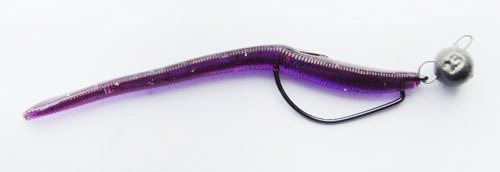
Worms are the most suitable type of bait for wacky style baits. So, some models of edible fish even have a specially sealed ring in the middle area to attach the hook there and keep it securely there.
This silicone worm, which plays attractively with its ends, attracts a wide variety of fish very well.
Silicone imitation crayfish are usually mounted with their claws backwards, so that there is a feeling of a real crayfish moving backwards, carried away by the fishing line. You can attach the crayfish to a jig head.

However, the game of silicone blende is revealed much better by hinged mounting. This can be a single or double hook.
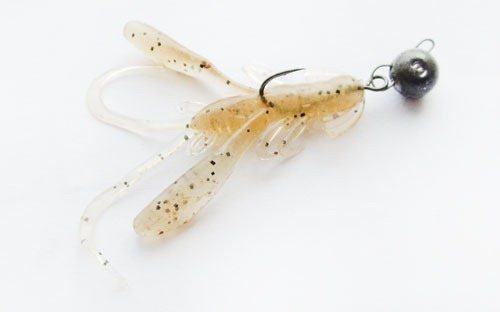
And, if they are caught in places rich in snags, the crayfish is attached to an offset hook.
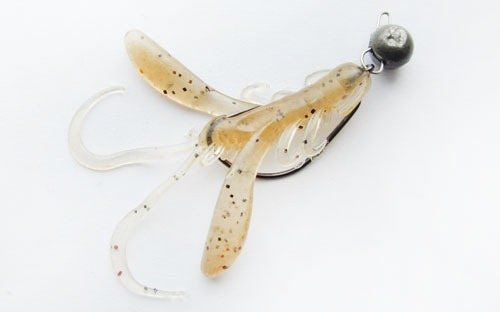
Despite the usual style of attachment, some models of crayfish can be attached, on the contrary, with the claws forward. This is especially true for models whose neck is weighted with salts.
Various cuttlefish and hybrids, strange silicone baits are very diverse. There are no uniform approaches to their installation. Look at the bait, which of the ones described above is most similar to it - then bait it.
Share with your friends:
Categories: Installations · Tags: Hooks, Installation, Silicone
Hinged mounting
Hinged mounting has recently become increasingly popular, as it provides the spinner with ample fishing opportunities. The hinged mounting is a lead (sometimes brass or tungsten is used) weight equipped with two rings or a collapsible design . Due to his resemblance to the famous cartoon character, he is often called “Cheburashka”. Hinged mounting has the following advantages:
- good aerodynamic characteristics;
- possibility of equipping with a single, double or triple hook;
- giving the bait additional play due to its movements left and right during retrieving;
- Possibility of making non-snacking installation.
The shape of the “Cheburashka” can be different: its choice is determined by the specific fishing conditions.
Single hook rig

Almost always, an offset hook . If there are no obstacles in the form of snags, aquatic vegetation and stones at the fishing site, you can fish with an open hook. The silicone bait is simply put on the offset machine in the same way as on the hook of a jig head. In order to prevent the bait from slipping, it is fixed with a special silicone stopper.

In blind spots, the hook point must be closed to resist various hooks. For this purpose, non-meshing installation . It is carried out as follows:
- The tip of the hook is used to pierce the head of the bait and bring it to the step on the shank of the hook.
- Fix the front part of the bait by putting a silicone stopper on the fore-end.
- Unfold the bait in the required manner and pierce the back of the bait so that the hook tip is either recessed into the body of the bait, or is brought out, but is located parallel to the body of the bait, barely protruding beyond its limits.
Expert opinion
Knipovich Nikolai Mikhailovich
Zoologist, hydrobiologist. I am interested in fishing at a professional level.
Important! When putting a silicone bait on an offset machine with a non-clinging installation method, you should pierce the head part, orienting the bait not the way it should be in the mounted state, but vice versa. Then, after turning over on the step, it will take the correct position.
It takes a little experience to learn how to make such an installation without errors.
A very convenient device for making non-snacking installations are special corkscrew springs . One end of the spring is screwed into the front of the bait, the other is attached to the eye of the hook. Not only is this mount more reliable than simply fixing the “head” of the bait on the offset step, it also does not injure the bait at all.
In order to give the bait a more natural position on the offset, they use not ordinary straight hooks, but special ones with a wide bend ( wide gap ).
Silicone crustaceans for fishing
When fishing, experienced spinning anglers often end up with crustaceans in their silicone bait sets. And this is no coincidence. Sometimes crustaceans can save a bad fishing trip. Most often, the object of fishing for silicone crustaceans is perch, less often pike perch and pike.
Why are crustaceans so effective when fishing for perch? Most likely, the shape of the body and the presence of legs and claws make the bait quite noticeable on the bottom. This silicone has its own game. Each leg can move and provoke the predator to attack. Another advantage, perhaps the main one, of silicone crustaceans is that they are large enough and are easily detected by fish.
The most effective retrieves using crustaceans are considered to be stepped, dragging along the bottom with pauses, and vertical with pauses.
Most often, the crustacean is attached to a hook with a spherical weight:
With this mounting option, you get better control of the bait. We can make a step, knock on the bottom and drag the crayfish. Naturally, they catch crustaceans in the bottom layer, since live crayfish can only be found at the bottom.
Sometimes a hinge joint is used. The paternoster is rarely used when fishing for crustaceans. This type of installation is appropriate when fishing on a snagy bottom or when fishing on a dump, when the load is separate from the bait.
If the bottom is clean enough, you can use a tee. In this case, good detection is guaranteed. In this case, the hook tips may be slightly pressed. If the silicone is soft, then the predator will be detected. When fishing with one hook, the sting should be parallel to the body of the bait at a distance of 3-4 mm, as in the photo above.
As for fishing places, they choose places with running water and hard areas of the bottom, where it is convenient to lead a large crustacean. You can try fishing under the bridge. In summer there is shade, the water is clean and there is a current.
For fishing for perch, crustaceans 4-5 cm long are best suited. They look like shrimp. The color of such silicone baits can be gray, light green, or brown. Small black dots are usually scattered throughout the body of such crustaceans. It was as if someone had taken a handful of black, loose material and sprinkled it on the bait.
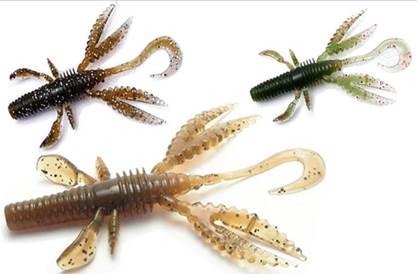
The most effective crustaceans for fishing predators are made of soft silicone and have long crabs and legs. Many models have tails in the shape of a question mark, like on twisters. During step-by-step wiring, these tails actively vibrate and thereby attract a predator. These models are effective when hitting the bottom intermittently, especially if the bottom is rocky.
Of course, the price of silicone crustacean baits will be slightly higher than twisters or vibrotails, but in some situations they turn out to be more catchy.
On a double hook
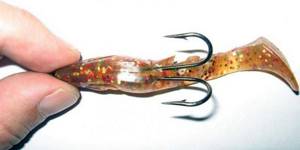
The silicone bait holds well on a double hook, is almost not injured during installation, the equipment flies far when casting, and the percentage of realized bites is much higher than when fishing with a single hook . Naturally, you should fish with a double hook if there are no hooks. Place the bait on the double as follows:
- The puncture site is determined by placing a double on the bait so that the eye of the hook comes out of the “head” of the twister or vibrotail.
- Slightly move the double hooks apart.
- Pierce the bait from the side and pull one of the hooks all the way through.
- Align the double relative to the body of the bait and push the fore-end forward until the eye appears from the head part.
Mounting a silicone bait on a double is used when fishing with a jig-spinning rod.
Expert opinion
Knipovich Nikolai Mikhailovich
Zoologist, hydrobiologist. I am interested in fishing at a professional level.
Healthy! Lures made from “edible” rubber have low strength. When casting, retrieving and biting, the bait begins to break, as it were, at the point where the double hooks exit. In this case, you should cut off a small piece from the head of the bait and attach the double on a new one. This operation can be carried out repeatedly until the bait loses its functionality.
Cancers
Date: February 17, 2015 | 275
Edible silicone sets the trend in jig fishing and modern lures. There are many forms of silicone and one of the prominent and noticeable ones is crayfish. Silicone crayfish are one of the best soft baits available today. This is not surprising, because the prototype of this bait was crayfish, crustaceans, which are the favorite food of fish in our reservoirs. So, among modern silicone baits, crayfish are very catchy and promising. Let's talk about crayfish in more detail, about their types, features and uses.
The shape of silicone crayfish is very similar to their living prototypes. Some models are very similar to living cancer exactly, while others are very conditional. The crustacean has two claws, mustaches, tentacle legs, and a characteristic body shape.

The size of crayfish can be small 1.5-2” or quite large – 3-4”. Silicone crayfish are designed to recreate a living food item, so they match in size. Small crustaceans imitate very small, recently hatched crustaceans, with a chitinous shell that has not yet formed. Large crayfish imitate already adult individuals, although not very large ones, because a large silicone crayfish will cut off too many medium and small fish. Even large adult crayfish have a hard shell, and they fight back with their claws, so that only very large fish can handle them.

A wide variety of fish are caught on silicone crustaceans. Perch of various sizes bites well on small crayfish, and small and medium-sized pike are often caught. It is not uncommon for a small crustacean to be tempted by a large peaceful fish: bream, carp, etc. Large perch, pike perch, pike, and catfish are regularly caught using medium and large silicone crustaceans.
There is an interesting point. It would make sense that silicone crayfish would be most effective in rivers and lakes where there is a population of real, live crayfish. However, practice shows that fish bite remarkably well on crustacean bait even in those reservoirs where there are no crayfish as such.
Crayfish are made of soft silicone, impregnated with an attractive smell to fish. The smell of molting crayfish, shrimp, squid, etc. the smells of animal organic matter are very good attractants for attracting fish to artificial crayfish, emphasizing its naturalness.
Silicone crayfish come in a wide variety of colors. However, translucent and dark colors are most in demand. Small crustaceans, as soon as they appear, are translucent, with visible insides. So, their imitations, translucent, light, with dark splashes of sparkles, are the most killer colors, especially in spring. Medium and large crayfish are good in dark brown, dark green, purple, and black shades.
I will give several examples of successful models of silicone crayfish. Bait Breath U30 Rush Craw, Bait Breath BYS Flappin Chunk, Bait Breath U30 Mosya, Reins Ax Crow Mini, Reins Ring Craw, Reins Ring Shrimp, Jackall Cover Craw, Lucky John Rock Craw, Lucky John Hogy Hog - these are the favorites. Although, besides them, there are many other models.
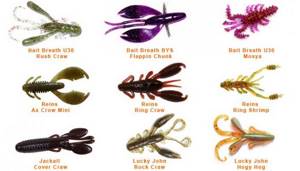
Crayfish should usually be mounted with their claws backwards. We will conduct the crayfish the same way as if a living crustacean were moving along the bottom. It is known that the crayfish moves backwards with its claws, so we mount the bait and carry it out that way. However, there are exceptions. When the crayfish is massive and specially loaded with salts in its lower part, it is equipped with an offset or single hook, on the contrary, with the claws forward. And with such light stretches and tosses they lead such a crayfish along the bottom. It seems that the crayfish is moving upward with its claws, as if defending itself from the fish that attacks it and tries to eat it. This greatly excites the predator to finally get to the crayfish and devour it. So, we use installation depending on the type of cancer, its design and features.

Most silicone crayfish are passive baits. So, you should give the silicone maximum freedom in movement so that the crayfish moves as quickly and naturally as possible and the fish thinks that it is real. This is achieved by hinged installation with a collapsible eared weight, etc. montages.
In addition to the classic microjig and jig rigs, silicone crustaceans are widely used in fishing with a retractable leash, in drop-shots, and other spaced rigs.
Wiring of the silicone crayfish should be done by manipulating the tip of the spinning rod. Simple wiring by slowly dragging the crayfish along the bottom is very effective. Also, jerking along the bottom with smooth pulls provokes fish very well. There is a huge field for experimentation here. Silicone crayfish can move naturally, very similar in habits to living crayfish, or they can behave completely unusually. In each particular case, the behavior of the edible fish causes a different reaction from the fish. You need to try, first, the classic methods of wiring - dragging, tosses with pauses. And if there is no result, make adjustments to the wiring, change something. This could be sharper jerks, or changing the duration of the pause, changing the bait, in the end. Sometimes it’s annoying when people take bait, use it a couple of times in one way and, without achieving any results, they start telling that the bait doesn’t work, that it’s not for our waters, and in general it’s a bourgeois bait for pumping out money. Like, we’ll fish with proven lures... Those who are creative and flexibly vary baits and fishing styles - they know how effective edible silicone is, and, in particular, crayfish!
Share with your friends:
Categories: Edible · Tags: Jig, Microjig, Lures, Crayfish, Silicone
On a treble hook
Mounting a silicone bait on a treble hook is a little more difficult. For installation you will need a short tube with a diameter of no more than 5 mm (for medium-sized baits). With its help, a hole is made in the side of the bait. First mark the place for the hole by attaching a tee so that the eye of the tee sticks out from the “head” of the bait.
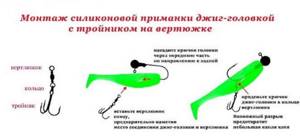
One of the hooks is pulled into the resulting hole, which should protrude from one side. Another hook is pierced from the inside of the back of the bait, the third hook remains sticking out from the other side of the bait. The eye of the tee is attached to the ring on the jig head or to the “ear” of the “Cheburashka”. The diameter of the hole is determined based on the size of the tee. A small hole will not allow the tee to be positioned symmetrically. A hole that is too large will lead to play in the tee, which will worsen the performance of the bait.
You can do it differently. A piece of thin wire is passed through the body of the bait so that it comes out at the beginning of the tail, and a swivel with a tee is attached to it.
On several hooks

When fishing with large-sized bait, it is often necessary to equip it with several hooks, since the predator is sometimes not detected. You can use the following two methods:
- An additional tee is hooked onto a regular or offset hook.
- A small tee is tied to a piece of thin wire, which is stuck into the back of the bait, and the other end of the wire is attached to the eye of the jig head.
Let's look at which fishing methods and which types of rigs are used.
Texas rig
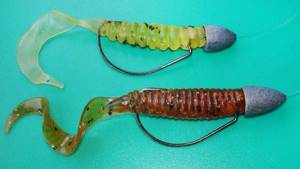
Texas equipment has almost 100% passability through obstacles and is used for fishing in snags, stones, and grass thickets. The Texas rig is a combination of a bullet-shaped sinker with a funnel-shaped recess in the back and an offset hook with a bait attached to it in a non-snagging version.
The offset machine's eye is hidden in the recess of the load, so the equipment does not have any protruding parts, due to which its unique properties are achieved.
Bait Breath RushCraw
This is one of my favorite worms for pike fishing! I classify the bait as passive, since it does not emit strong and powerful vibrations due to any active elements. But this fact does not prevent her from catching toothy fish well. I started using the bait on the most common articulated rig with an offset rig. I caught it using a classic jig with stops, or dragging along the bottom (also with wiring stops). The pauses need to be very long. During this phase, the pike approaches the bait and, after starting to reel, rushes at it.
Just recently I saw on YouTube a video of the game RushCraw on the Neko rig. Liked. I also decided to try fishing as in the video. I must say that the tests were successful in terms of biting! I got a lot of bites during the day, and in a place where the fishing pressure is very intense. But the realization of these bites was almost zero, which cannot be said about the statistics on the loss of bait. Four out of six bites resulted in the loss of the crustacean. Because This rubber is expensive, I decided not to continue the experiments and fish with the most ordinary equipment with a Cheburator.
Carolina rig
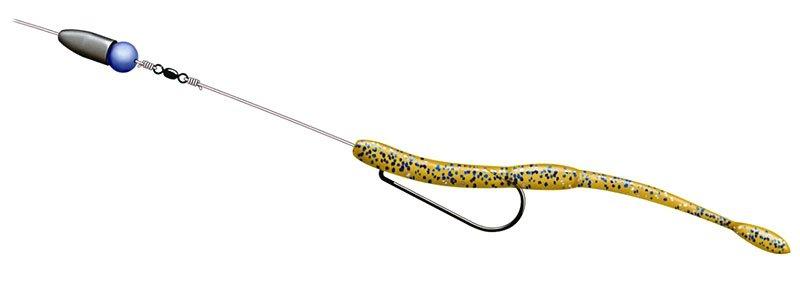
The Carolina rig consists of a sinker, which also has a bullet or olive shape; beads that prevent the knot from breaking and create sound vibrations; a swivel and a leash attached to it with a hook on which a silicone bait is attached. with a Carolina rig both in areas with a clean bottom and in “dead” places . In the first case, the tip of the hook is left open, in the second, a non-snagging installation of the bait on an offset hook is used.
Installation of silicone baits (on offset and single hooks, double and jig head)
In this article we will talk not only about different types of rubber installation, but also dig a little deeper. You can not only read and watch pictures of the montage, but also see a specially prepared video where the multiple world champion will share his experience with our readers.
How to choose the right hook for installation
It should immediately be noted that the installation of traditional silicone bait and twister on offsets has certain differences, therefore, different hooks are chosen when using one or another bait. In this regard, every fisherman is recommended to have several baits in stock. It often turns out that in one body of water the fish bite better on a twister, and in another - on a silicone fish.
So, if you have chosen an ordinary fish, you need to select a hook for it, the length of which will be approximately ½ of the body of the bait. When using a twister, the size of the hook should be approximately the length of the entire head of the bait (to the tail, with an indent of literally a few millimeters). If the grip is too large, the bait simply will not vibrate well enough and, therefore, will not attract the attention of the fish.
When using newfangled twister worms, you should also be guided by the rule that the length of the hook from head to base is equal to half the silicone bait (excluding the vibrating tail).
Installation of silicone bait on an offset hook
The easiest and most recommended way to mount bait on an offset hook is through the front of the fish. This option is also suitable when using a jig head (a hook soldered into a lead base).
First, the piercing part of the hook is pierced through the “mouth” of the bait and exits through the “neck”. All that remains is to unfold the hook (twist it), and then hook it onto the belly of the silicone.
The offset eye above the bait should protrude only a few millimeters (the smaller the better). A jig or so-called “Cheburashka” is attached to it. And don’t forget that you can always buy monolithic silicone baits at a fishing store.
To consolidate what you have read, watch this video on installing an offset hook and everything will immediately fall into place. Briefly and clearly.
Installation of silicone bait on a double hook
When installing a silicone bait on a double hook, the belly is first pierced (with only one needle), then it is pulled to the eye, which must be carefully squeezed through the inside of the bait to the neck.
The twister is attached in a similar way, but only the first puncture is performed directly in front of the vibrating tail. For silicone fish - approximately in the middle of the body (here you will have to completely pierce the belly right through). In this case, the double is preliminarily expanded manually by 4-7 millimeters (depending on the size of the bait itself).
In this video example, which we specially prepared for this issue, you will see how simple everything really is.
Using a jig head when mounting rubber baits
A jig head is a special weight with a hook attached to it. To mount a silicone bait on such a jig head, beginners first place the hook on the bait to understand where it should come out. Then they pierce the bait through the front part and push it exactly along the middle to the predetermined point where the hook will emerge. Exited through the back. Everything is as simple as always and it’s just a matter of choosing the right hook, loading the jig head and gaining a little experience. Watch the video and you will understand everything.
Single hook mounting
This installation is very similar to the installation of a jig head passing through the entire bait, with the only difference being that we use a swivel joint with a Cheburashka weight. Watch this video about the advantages of such installation:
Other methods for installing silicone baits
Fishermen also practice the so-called “double installation” of silicone bait.
That is, the eye of the second one passes through the piercing part of the hook. Thus, you can combine both a fish and a twister, different colors of baits, and their sizes. In one of the baits, you can make notches on the tail (using an empty ballpoint pen), which will allow it to vibrate more strongly. This method of mounting bait is recommended for use in cases where fishing is planned in an unexplored body of water, and the fisherman simply does not know how the fish behave here.
How to choose the right silicone bait?
A question that could be blown out into an entire scientific treatise and still not please everyone. The surest method for a beginner is to consult with more experienced colleagues. They will tell you what exactly the fish prefer in your area. You also need to proceed from the fact that not all spinning rods can fish equally well with different silicone baits, which means that you will have to select one that suits your gear. It is also true that even with a relatively low weight of bait, it can be used by choosing the right equipment. Read what a diverter leash is or its small modification - a Tyrolean stick.
Now it is very fashionable to use edible rubber (silicone baits with specially smelling attractants). Among the cheap and working edible silicone on store shelves, Lucky John stands out. We have personally tested these baits, and we can safely say that they work.
Drop shot
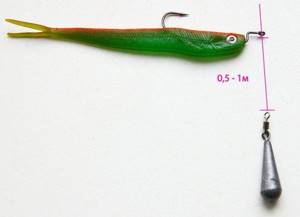
When fishing with a drop-shot rig in places without hooks, they often use not an offset hook, but a regular hook. In snags and grass you can’t do without an offset tool. A hook with a bait, set in a non-swimming version, is tied with a special knot so that the hook is perpendicular to the main line or the line of the leash, and the tip points upward.
How to attach a silicone bait to a double
The double hook, when used together with edible silicone, provides some advantages over other installation options.
To the positive aspects of the flail.>
- Beginner fishermen rarely use this type of equipment, since without additional instructions the process of attaching bait to a hook is not very clear.
- A double hook causes more damage to the bait, which has a negative impact on its lifespan.
It can be difficult for anglers who first started using a double hook without the help of more experienced comrades; it is usually difficult for them to figure out what the correct equipment for a vibrotail or twister should look like.
A common mistake is to place the bait on only one shank of the hook, leaving the other free. This action leads to a violation of the symmetry of the bait, and therefore worsens its performance, which can negatively affect the catch. Let us make a reservation that experienced fishermen sometimes use this method and disrupt the play of the bait, but this does not always happen. Understanding the appropriateness of such installation comes with experience.
After selecting the hook of the required length, you must:
- Align the hook with the bait so that the eye looks out of it, as in the finished installation.
- Mark the place from which the hook should come out.
- Then you need to move the hooks slightly apart and make a puncture in the indicated place.
- The rubber must be pulled onto the hook until the eye is hidden in the body of the bait.
- The eye is then pushed through the bait until it comes out of the front of the vibrotail.
There is an even simpler way. You can attach a vibrotail to a double in one movement; you need to pierce the bait with the eye in the place where the hook should come out of it and remove it from the front part.
This method is well suited for baits with a high body. In the case of small-volume baits, this is not recommended.
Wacky equipment
Wacky rig as a type of installation and fishing method came to us from North America, like other methods of fishing with silicone baits. The main catch of American fishermen was bass, but in our country, with the help of a weki rig, you can catch various predatory and semi-predatory fish. The equipment has proven its effectiveness when catching passive predators or in pressed-in reservoirs.
However, among domestic fishermen, few are familiar with veki, not because its installation or animation presents any difficulties, but because of their commitment to traditional fishing methods. The weki rig is used when fishing for pike in grass windows, perch among stones and in some other situations.
Expert opinion
Knipovich Nikolai Mikhailovich
Zoologist, hydrobiologist. I am interested in fishing at a professional level.
Interesting! There is not a single spinning bait or fishing method invented exclusively for catching largemouth bass that domestic fishermen have not adopted and adapted to fish living in Russian waters. This fact testifies to the significant creative potential of our people.
To install the veki equipment, an offset hook with a fairly wide hook . Silicone worms, preferably “edible” ones, are usually used as bait. You can simply stick the hook in the middle of the bait’s body, but with this type of equipment it will not withstand even a couple of bites. Therefore, the following actions are usually taken.
To make the veki equipment you will need a rubber ring, which you can make yourself. To do this, tie the rubber band with a thread (or a braided cord) so that a loop is formed. Trim off the excess elastic and thread, then put the resulting ring on the Superglue cap. Insert the head part of the silicone worm into the cap and tighten the elastic band onto the body of the bait, placing it in the middle of the worm. The hook is attached to the ring. The equipment is ready.
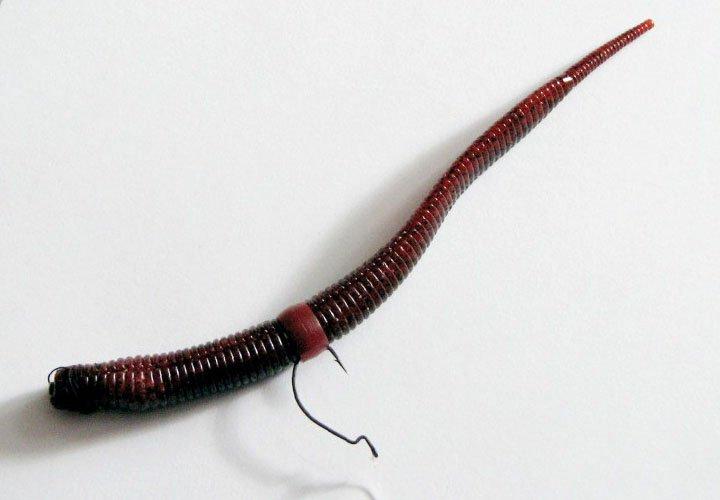
Often the front part of the bait is surrounded by inserting a piece of nail into it. When fishing in thick grass, you can use hooks with wire protection. The animation of the bait is random jerks with pauses.
Silicone worms for fishing
Silicone worms were originally designed for catching large American bass. However, as it turned out later, pike, pike perch, carp and even bream bite well on such bait.
Silicone worms most often have brown, dark red, orange and greenish colors. Outwardly, they resemble an earthworm. The body has a ribbed surface, rings, and the tail is often flattened. Naturally, there are both round and flat worms of different lengths and diameters.
Worms also vary in toughness. There are worms that crumple like paper, and there are very tough ones that hardly play in the water. Some models have tails very similar to twisters. There are multi-component models consisting of segments. Such worms show the most active and dynamic play.
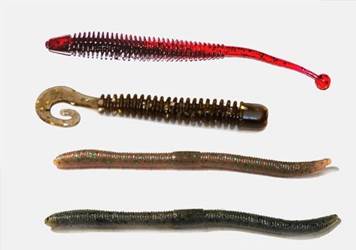
Worms with a soft and playful tail are best suited for Texas rigs, for dragging along the bottom and for step retrieves. The Texas worm rig looks like this:

Due to the fact that the weight and bait are located separately, a more varied game is obtained. At the bottom, such a worm looks natural and is very reminiscent of a long swamp or earthworm. If you twitch it a little with a spinning rod, the worm “comes to life” and seems to move and crawl.
When performing stepwise wiring, the worm is driven in the bottom layer. When it falls, take a short pause. This turns out to be a completely plausible imitation of a falling crawl.
Very often, worms are attached to a retractable leader or a drop-shot rig is used. This is what a worm with a dropshot rig looks like:
To make a dropshot rig, take a piece of fluorocarbon fishing line with a diameter of 0.25-0.3 mm and a length of 50 cm. A carabiner fastener is tied at one end. A weight is attached to the second end. Next, a palomar knot is used to tie a hook at a distance of 30-40 cm from the weight with a soldered swivel. Typically a cylindrical weight is used, as shown in the photo above. You can attach a carabiner with a clasp to the end of the fishing line. This will create a mobile equipment in which weights can be easily changed. Another option is to use weights with soldered clasps or carabiners. In this case, it is enough to make a loop at the end of the fishing line.
They also use a regular Cheburashka weight or a hook with a soldered weight on which a worm is attached. It turns out this simple equipment:
Most often, the drawing method with long pauses is used for such equipment. It happens that a carp willingly takes such a worm. It is enough to throw it into a hole or exit from it and wait a little, as when fishing with a bottom. While waiting, it is advisable not just to smoke, but to move the fishing rod a little. It is during such movements that the carp can take hold.
Something else needs to be said about the size of the worm. Its length depends on the object being fished. If we want to catch a perch, then we use worms 4-5 cm long. If we are targeting pike perch, pike or carp, then we use a larger worm, from 7 to 10 cm. The hook is selected accordingly. The worm is threaded as shown in the photo above. It is better to have several such equipment for different fish. This way you can easily change them while fishing and you won’t have to tie them.
The most common colors of silicone worm baits are swamp, dark green, light brown, dark red and black.

Many manufacturers produce silicones with different scents. Worms are no exception. The term “edible rubber” was coined for such baits. Edible for fish. But not all worms have high-quality flavored impregnation. To understand how correctly they are flavored, you need to take one of the baits and tear off a small piece from it. Then we just roll this piece between our fingers and see what happens. If you can see granules and grains of salt inside the silicone, it means it is well flavored and will smell the entire time you use it.
Spinners who actively use silicone worms have noticed the preferences of predators. Thus, when catching active and large pike, the most effective are ribbed models 8-10 cm long, as well as lures with deep notches - rings throughout the body. It is good to fish with such worms in the coastal zone, especially near reeds and grass.
Another good equipment for catching predatory fish is with a retractable leash. This is a common equipment that is suitable for fishing the bottom layer. She looks like this:
This option is one of the best. The weight and worm are easy to change. There are situations when a shorter or longer leash is required. In this case, you can use leashes with fasteners. Such leashes can be quickly removed and quick changes can be made. Leashes are best made from rigid fluorocarbon fishing line. Stiff line minimizes overlaps. When fishing for pike, it is better to use leashes made of string or tungsten.
The meaning of a rig with a retractable leash (it is also called a paternoster) is that when slowly moving along the bottom, the worm will slowly swim, and the weight will successfully overcome obstacles at this time. If you fish on a clear bottom, you can pause. During stops, the worm will lie on the bottom and it is quite possible that the fish will become interested in it. This could be perch, pike perch, pike and the same carp.
The length of the leash depends on the activity of the fish and the strength of the current. The more careful the fish and the stronger the current, the longer the leash is used. The principle of selecting leashes is approximately the same as in feeder fishing. On average, the leash length for a silicone worm is from 30 to 80 cm.
Features of installation of vibrating tails
A vibrotail is placed on a jig head hook or on a single hook attached to a Cheburashka by simply putting the bait on the hook. There are no difficulties when equipping a vibrating tail with a double hook. However, a vibrating tail mounted on an offset hook in a non-hooking type does not always meet the requirements associated with the implementation of bites.
The fact is that a vibrotail, especially one with a high body, is not pressed down when biting so that the sting is exposed to the limit necessary for an effective hook. In other words, the number of idle bites does not contribute to effective fishing. Therefore, it is recommended to install the vibrotail sideways , i.e. sticking the hook point into the side of the bait. Although this installation does not look familiar, the performance of the bait does not deteriorate.
Silicone baits: types and installation methods
Today, one of the most common methods of fishing is fishing with silicone baits. In all fishing stores you can find many types of bait. All of them are colorful and differ not only in appearance and pricing policy, but also in their purpose. Such a huge variety of products offered will allow a real fisherman to easily develop his fishing skills. All you need to do is learn how to mount a silicone bait correctly, and this is an entire art.
Types of silicone baits
Let's start, perhaps, with the types of baits themselves, what shapes they have and what is their difference.
- Twisters (or, as they are also called on the World Wide Web – grubs)
These lures have a curled tail and a smooth or ribbed body. By the way, they can also have more than one tail - and all of them can have some completely unusual shape. The size also varies from 1.5″ to 6″. Of course, there are larger twisters, but their use is very specific. Many professional fishermen claim that the optimal size is 5″. It is excellent for pike fishing.
Twister is an active, moving bait. If you use a straight line, the tail of the twister will begin to flutter, thereby inviting the fish to take a closer look and swallow the delicious bait.
- Vibrotails
This bait is shaped very much like a real fish. The tail of this “fish” is flat and is located either perpendicular or at a slight angle to the axis of the bait’s body.
There are very, very many shapes, types, colors, various tail shapes, and tastes of vibrotails. Sizes can reach 10 inches.
The most commonly used baits are from 2 to 4 inches in size, less often - 5. Pike, pike perch and perch work very well on them. For larger baits you will need heavier gear, since the weight of such vibrating tails can reach up to 30 grams.
Silicone vibrotail is an active type of bait. Already at the lowest speed, the bait starts working. It is worth noting that without experience and certain knowledge, choosing the correct shape and size of the body and tail of a vibrotail for fishing in certain conditions will be very difficult. This bait is not for beginners.
- Silicone worms
Already from the name you can guess that the shape of this bait resembles real worms. They can be short and thick, or they can have a fairly elongated shape and be soft. In addition to the banal shape of earthworms, silicone worms may also have a forked tail or blade, and the presence of other silicone elements may be observed.
Silicone worms can also be used together with other baits. Perch, pike perch and possibly pike will bite on the worms.
- Slugs
This type of bait is not as popular as, for example, a twister or a vibrotail. This is a passive bait. It is used most often by experienced fishermen who are confident in its use. In other cases, the slug is used more as an experimental bait.
This bait is absolutely nothing special; there are no playing parts in it. With weak wiring, if the slug plays, it will be barely noticeable and only with the whole body. Perhaps this is its main charm. In this case, the fisherman himself can give the bait the necessary game.
- Silicone crayfish and creatures
This bait can either be as close as possible to a real crustacean, or only vaguely resemble it. Silicone crayfish are most often used for catching perch. It is this fish that loves to hunt for crayfish during their molting period.
It is best to move the crayfish along the bottom in small jerks. It would be a good idea to pause and then continue the game.
The creature, in its appearance, does not resemble a single sea or river inhabitant. Essentially, translated from English, creatures is “creature”. The bait can move independently even with a barely perceptible current. They come in all different shapes and flavors and with a wide variety of aromas.
- Silicone frogs
Naturally, this bait looks like a real frog. This bait is floating, so it can be used for good fishing in water bodies heavily overgrown with reeds and other vegetation.
A distinctive feature of this frog is that it is sold with built-in hooks that are directed straight up. However, in some cases it can be sold without them, then the fisherman himself places the offset hooks as he needs.
Such baits are aimed primarily at pike, which lives in the above-mentioned places. The wiring can be different: straight with twitching or jerky. You can try making pauses in the wiring - this will make it more attractive.
- Silicone pipes (tubes)
The most unusual bait that has no living analogues in freshwater bodies. Its distinctive feature is that it is empty inside. This is done specifically so that the cargo is located inside. The tube's tail ends in several variegated processes that look like tentacles. The bait itself resembles a small squid.
Most often, tubes are used to catch predators, although only passive ones.
Methods for installing silicone baits
There are many ways to attach silicone baits. Naturally, each of these methods has its pros and cons in certain fishing conditions. Let's look at several methods of mounting baits, and also find out for what conditions the chosen method is best suited.
Classic equipment for silicone baits
Let's start with the classic equipment. This method can be safely called the easiest and simplest. Both beginners and experienced spinning players resort to it. What makes this type of installation different is the use of a jig head.
A jig head is a weight and a fixed hook soldered to it. The weight category of this thing can be different: from 1 gram and above. Hooks, accordingly, will also differ in size. The head itself can be of different shapes: spherical, ellipsoidal, in the form of a rugby ball and in the form of a hoof. Proper rigging of the bait requires the correct weight of the jig head and the correct selection of the hook. To do this, you must take into account the fishing conditions.
If you think that the bigger the hook, the better it is, then most likely you are a beginner. By piercing the body of the bait right through, you leave it very little opportunity for independent play. Of course, there is the fact that a large hook significantly reduces the number of empty bites, but you shouldn’t get hung up on it.
Hinged mounting of silicone baits
A head weight, also called an eared hook or a Cheburashka, an offset hook or a double (sometimes a tee) is all you need for this installation. The weight-head has two ears: we hook an offset hook into one, and a leash with fishing line into the other. It is thanks to this that the hook with bait will always be movable, and additional vibrations will be created when retrieving. Installation is also convenient because hanging another bait on an eared weight, or vice versa - putting a heavier weight on the bait - will not be difficult and will take very little time.
Texas rig
This species came to us straight from America, but quickly won the hearts of both experienced spinners and beginners. This method is especially good if you fish in places where there is a lot of underwater vegetation.
You will need an offset hook and a bullet shaped head weight. As a rule, all equipment is assembled on a fluorocarbon leader. Equipment collection method:
- the load should be strung on the main line, with the pointed part of the bullet facing the rod;
- a silicone shock absorber is placed on the fishing line; if you don’t have one at hand, you can use a bead or a small plexiglass ball;
- an offset hook is tied to a fishing line;
- the bait is placed on the hook.
How to attach bait to a hook:
- pierce the worm from the head along the body about 5 mm. The sting is brought out;
- pull the hook through the worm, turn and pull the bait onto the step of the hook;
- pierce the worm across again and bring the sting out. The sting should fit snugly to the body. The tip can be hidden in the body for better maneuverability in the grass.
IMPORTANT! Do not forget that you need to select the correct ratio of hook, bait and sinker. The equipment is assembled on a metal leash only in cases where you are assembling it for pike. It is this factor that will protect it from the sharp teeth of a predator.
Carolina rig
This type of installation is somewhat reminiscent of Texas rigging. By the way, he also came to us from America. Carolina rigs are also best collected on a fluorocarbon leader. What's the difference? The problem is that the weight-head (in the form of a bullet) needs to be mounted 50 cm higher from the bait itself. You can even increase this distance to 1.2 meters. Do not forget that the head weight must be on the main line, and the leash can be tied to it using a swivel.
When using such equipment, the following effect is obtained: when the load is already on two, your bait floats in the water column. This is why it is very important to choose a bait with good buoyancy. Wiring should be done with light tightening or almost imperceptible twisting of the coil. This way the load will create a cloud of turbidity, and it is known to attract fish very well.
Which bait methods are best for different baits?
Now that you know all the types of baits, as well as how to mount them, all that remains is to figure out the last question: which methods are best suited for different baits?
For example, twisters, slugs and worms are best used on Carolina and Texas rigs. But in the case of hinged mounting, a vibrating tail and worms are best suited. You can also use a twister. In classic installation, the use of almost all baits is allowed.
Despite all the tips and recommendations, it is always worth remembering that the choice of bait and rigging method largely depends on the fishing location, fish and other conditions. So, be careful and, as they say: “No tail, no scales!”
See also the video “9 ways to install silicone baits”:
comments powered by HyperComments
Source: fish.rybalkanasha.ru
